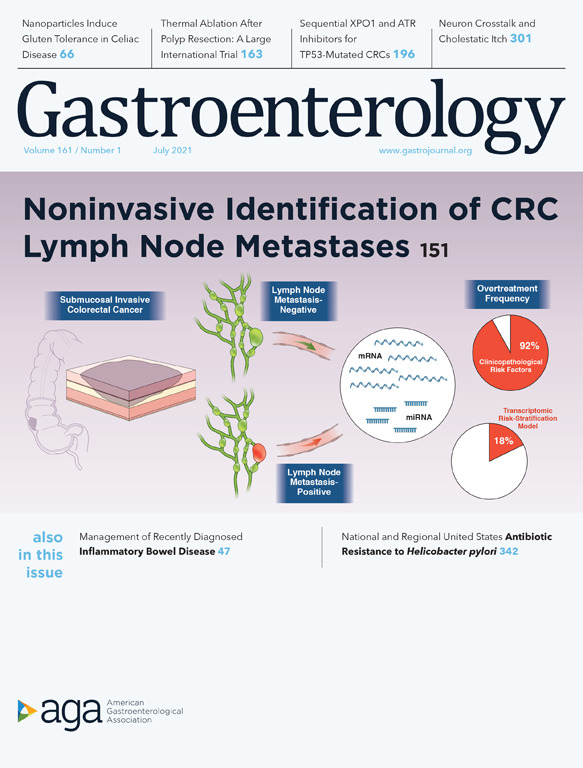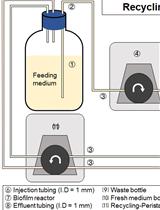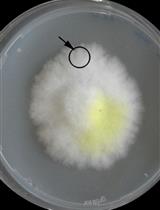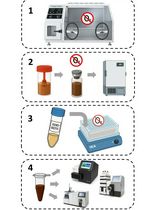- EN - English
- CN - 中文
An Inexpensive Imaging Platform to Record and Quantitate Bacterial Swarming
记录和定量细菌群集的廉价成像平台
发布: 2021年09月20日第11卷第18期 DOI: 10.21769/BioProtoc.4162 浏览次数: 3471
评审: Alba BlesaTimo A LehtiAnonymous reviewer(s)
Abstract
Bacterial swarming refers to a rapid spread, with coordinated motion, of flagellated bacteria on a semi-solid surface (Harshey, 2003). There has been extensive study on this particular mode of motility because of its interesting biological and physical relevance, e.g., enhanced antibiotic resistance (Kearns, 2010) and turbulent collective motion (Steager et al., 2008). Commercial equipment for the live recording of swarm expansion can easily cost tens of thousands of dollars (Morales-Soto et al., 2015); yet, often the conditions are not accurately controlled, resulting in poor robustness and a lack of reproducibility. Here, we describe a reliable design and operations protocol to perform reproducible bacterial swarming assays using time-lapse photography. This protocol consists of three main steps: 1) building a “homemade,” environment-controlled photographing incubator; 2) performing a bacterial swarming assay; and 3) calculating the swarming rate from serial photos taken over time. An efficient way of calculating the bacterial swarming rate is crucial in performing swarming phenotype-related studies, e.g., screening swarming-deficient isogenic mutant strains. The incubator is economical, easy to operate, and has a wide range of applications. In fact, this system can be applied to many slowly evolving processes, such as biofilm formation and fungal growth, which need to be monitored by camera under a controlled temperature and ambient humidity.
Keywords: Bacterial swarming (细菌群集)Background
Bacteria show different motility phenotypes, such as swimming, swarming, gliding, sliding, and twitching (Kearns, 2010). Coordinated multicellular migration across a moist surface, known as bacterial swarming, is an important motility phenotype that has been studied for decades due to its relevance to pathogenicity, virulence, and antibiotic resistance (Kearns, 2010). A systematic study of colony expansion speed and morphological patterns coupled to swarming may provide insight into the correlation between bacterial motility and host health. Here, we build an environment-controlled incubator to perform a swarming assay. Inside the incubator, a digital camera is mounted on the top to take time-lapse images of the swarming activity. After the recording, images are transferred to a laptop for quantitation of the swarm expansion using the ImageJ software. The system was tested by recording over 1,000 swarming events to assure stability and reproducibility.
At first glance, one may consider a swarming assay rather simple: just inoculate bacteria on agar filled in a Petri dish, and then take an image of the plate after incubating for a certain time. However, it can be challenging to perform swarming assays with reproducible results and record clear images for further quantitative analysis. Here, we list a few technical challenges that one may encounter and provide corresponding solutions in our protocol:
A typical swarming event may take 10-20 h for the bacteria to cover a standard 9-cm Petri dish. Besides the coverage time, sometimes we need to know how long the lag phase lasts, at what time branches form at the colony edge; and at the microscopic level, when cell elongation occurs. Thus, the researcher needs to check the plate regularly, aided by microscopy. Suppose one starts the assay during the daytime; one may need to scan the plates every 10-30 min overnight. In our protocol, time-lapse photography helps to capture images so that the researcher does not have to stay up late or check every 10-30 min in order not to miss key events.
Bacterial swarming is highly sensitive to the environment. Fluctuations in ambient temperature and humidity often cause large differences in the swarming rate and colony pattern; therefore, a stable humidity- and temperature-controlled environment is critical for the assay. In our system, we utilize a thermo-insulating tent, a humidity control unit, and a temperature control unit to minimize the environmental fluctuation during the assay. One can readily set different humidities and temperatures for a swarming strain screen.
Since an agar gel typically contains over 97% water by mass, condensation readily forms on the plate lid, which obscures image taking. We designed the incubator in such a way that, when the plates are placed inverted on the platform, the temperature of the lid is slightly higher than that of the agar, which prevents condensation. Note: the agar surface architecture can vary depending on pouring methods, thickness, and percentage of agar used; these need to be individually optimized for the particular bacteria.
Taking a clear photo of the swarming plates is tricky. A swarming plate has three surfaces that affect the optical quality while imaging: the plate lid, the agar surface, and the plate bottom. When the camera flashlight or auxiliary front light is used, some light is reflected by the lid and the bottom of the plate to the camera, forming undesirable light spots on the photos. In our design, for one-plate photo shooting, we use a circular fluorescent tube as the backlight under an adjustable light shield. For multiple-plate (up to 9) assays, an LED light strip is used for sidelight illumination. Image quality is better when using the light shield because of the light field setting; however, the efficiency is higher when using a LED light since it illuminates a larger area that can fit 9 Petri dishes at a time.
Quantitation of the swarming rate takes a lot of effort; researchers generally scan the plates and measure the radius of the swarming colony using a ruler. For an irregular-shaped colony, they usually make a rough estimation of the “effective radius.” When multiple plates are involved in the assay, one should plot the swarming area vs. time instead of just calculating the average swarming rate. A lot of work is required for numerous manual measurements. In our case, we import the digital swarming images to the ImageJ software and calculate the swarming area by outlining the swarm periphery. This computerized process improves the efficiency and reduces the error.
Compared with conventional practice in this field, our protocol has distinct advantages:
(1) Affordability. In 2015, a research team headed by Dr. Joshua Shrout at the University of Notre Dame described a protocol for the preparation, imaging, and quantitation of swarming (Morales-Soto et al., 2015). In their protocol, they used the commercial equipment “Bruker in vivo imaging station.” This product is no longer available from the company, and a used one costs over $58,000. Most microbiology labs studying bacterial swarming may not need many of the complex functions that this particular equipment provides, such as x-ray imaging and in vivo fluorescence imaging. Those labs may not be able to afford or be willing to invest so much in an overqualified bacterial swarming chamber. In contrast, the total cost of our system is around $1,000, with everything included.
(2) Accuracy. For the Bruker imaging station, placing a plate of water next to each swarming plate is suggested in order to maintain humidity. In this way, however, it is hard to control the humidity within a specific range. In our design, the chamber humidity is well controlled; one can set the parameters before the assay starts, and the environment is controlled dynamically using a digital sensor and feedback controllers.
(3) Efficiency. In 2018, an independent researcher, Peñil Cobo, developed a time-lapse imaging chamber for bacterial colony morphology observation (Peñil Cobo et al., 2018), which allows for photography of one Petri dish at a time. Since the temperature is not controlled in that design, the whole system must be placed in a warm room. In our case, multiple 9-cm Petri dishes can fit inside the incubator, providing convenience and efficient use of space and energy. Having a larger box in our design, necessary to hold multiple plates, alters the optical path in a subtle way, but the geometry of our incubator and light field for photography are well calibrated to ensure the best lighting.
This protocol is divided into three steps: (1) assembly of an incubator; (2) the swarming assay; and (3) data processing. By following the procedure as detailed below, we guarantee that one can obtain a homemade bacterial plate incubator with stable swarming results and high-quality images. The overall cost depends on which camera is used in the system, but it should be within $1,000 dollars. In practice, any digital camera that has a “Manual Mode” is adequate for the purpose. A swarming assay requires researchers to be meticulous with certain details to ensure reproducibility. For instance, bacterial swarming is very sensitive to small changes in conditions such as the roughness and moisture level of the agar surface. Here, we attempt to elaborate on procedures and notes in as much detail as possible for users to follow. In the photo shooting part, we show in detail how to tune the camera settings. Finally, we explain how to process the data using ImageJ to measure the swarming area.
Materials and Reagents
To build the photographing incubator
Hydroponic Indoor Garden Grow Tent (24 in. × 24 in. × 48 in., Yaheetech, model: YT-2801)
Photography unit
Digital camera (Panasonic, model: DMC-FZ50)
LCD Timer Remote Control (JJC, model: TMD)
AAA battery (2 pcs, Duracell)
Zinc-plated slotted angle (4 pcs, 1.5 in. × 14 Gauge × 36 in., Crown Bolt)
Zinc-plated slotted angle (10 pcs, 1.5 in. × 14 Gauge × 18 in., Crown Bolt)
Aluminum flat bar (0.75 in. × 36 in. × 0.125 in., Everbilt)
Black polyester cloth (20 in. × 20 in., Dazian)
Bolts and nuts (40 pairs, M5, Crown Bolt)
Black acrylic sheet (2 pcs, 18 in. × 18 in. × 0.125 in., National Security Mirror)
LED light strip (3 meters, White, GuoTonG)
Power strip (6-outlet, Belkin)
Backlight shield
Black acrylic sheet (3 pcs, 12 in. × 12 in. × 0.118 in., National Security Mirror)
Fluorescent circline ceiling light (Sunlite, model: FC12T9/CW) with starter ballast
Zinc-threaded rod (4 pcs, 0.25 in. × 12 in., Everbilt)
Hex-plated nuts (24 pcs, 0.25 in., Everbilt)
Temperature and humidity control unit
Heated control module (Coy Lab, serial: DC1807)
Fan (AC Infinity, model: LS1225A-X)
Digital humidity controller outlet (Inkbird, model: IHC200S)
Reptile humidifier (2 L, Evergreen)
Beaker (500 ml)
Note: Other brands of humidifiers or controllers can be alternatives if their combination can well control the humidity inside the chamber.
For swarming plate preparation
Enterobacter sp. SM1, SM3, SM3_18, SM3_24 (species of bacteria for the swarming assay)
LB broth (see Recipes)
0.5% LB agar plates (see Recipes)
Equipment
Labconco Purifier Class II Biosafety Cabinet (Delta Series)
Falcon 14-ml Polystyrene Round-Bottom Tubes (17 mm × 100 mm, Corning)
Sterilized wooden sticks (2.5 in.)
Pipet-aid (Drummond, 1-100 ml) with appropriate pipette
New Brunswick Innova 4300 Incubator Shaker
Weighing paper (4 in. × 4 in., Fisher Scientific, catalog number: 09-898-12B)
Laboratory spatula (4 pcs, 6.5 in, stainless steel, Home Science Tools)
Pyrex glass bottles (250 ml, Corning, model: 1395)
Pyrex graduated cylinder (500 ml, Corning, model: 3022)
Hot plate magnetic stirrer (Barnstead International, model: SP46925)
Thermal insulating gloves
Autoclave (AMSCO Scientific, model: SV-120) with autoclavable tray
Petri dishes (100 mm × 15 mm, sterile, polystyrene, Fisher Scientific, catalog number: FB0875712)
Micropipette (0.5-10 μl, Eppendorf, catalog number: 3123000020)
Acrylic cutter (Fletcher)
Circle cutter (Bott)
Hand drill/table drill with appropriate drill bit set
Hacksaw
Software
ImageJ (ver1.59g) (https://imagej.nih.gov/ij/)
Procedure
文章信息
版权信息
© 2021 The Authors; exclusive licensee Bio-protocol LLC.
如何引用
Chen, W., Mani, S. and Tang, J. X. (2021). An Inexpensive Imaging Platform to Record and Quantitate Bacterial Swarming. Bio-protocol 11(18): e4162. DOI: 10.21769/BioProtoc.4162.
分类
微生物学 > 微生物-宿主相互作用 > 细菌
微生物学 > 微生物生物膜 > 生物膜培养
生物科学 > 微生物学 > 微生物群落 > 微生物组学
您对这篇实验方法有问题吗?
在此处发布您的问题,我们将邀请本文作者来回答。同时,我们会将您的问题发布到Bio-protocol Exchange,以便寻求社区成员的帮助。
提问指南
+ 问题描述
写下详细的问题描述,包括所有有助于他人回答您问题的信息(例如实验过程、条件和相关图像等)。
Share
Bluesky
X
Copy link












